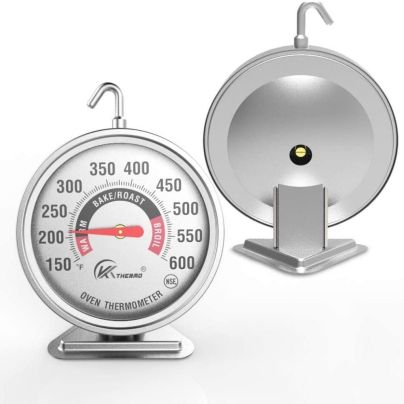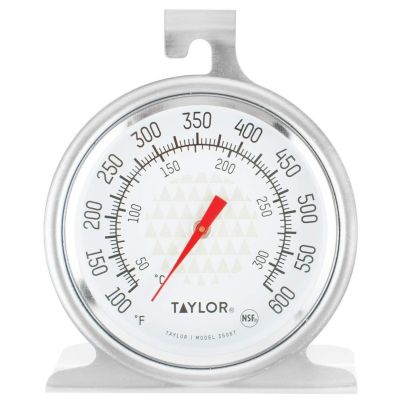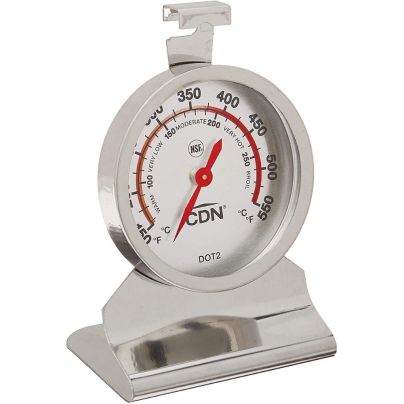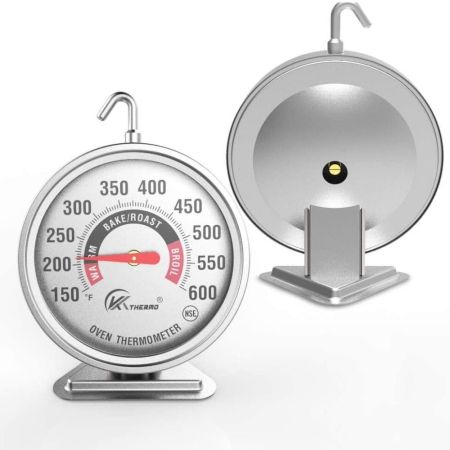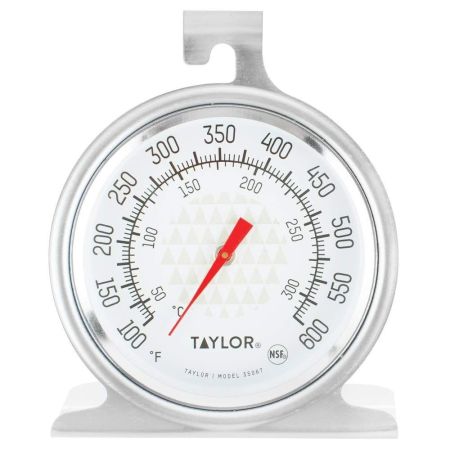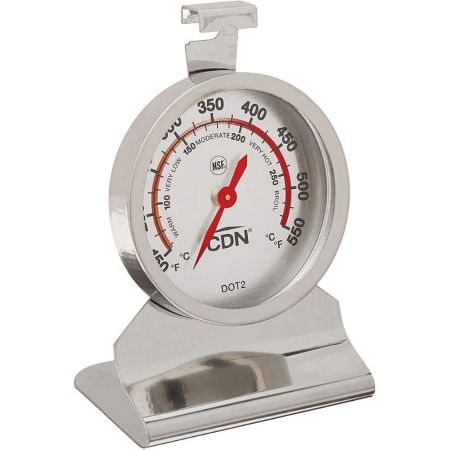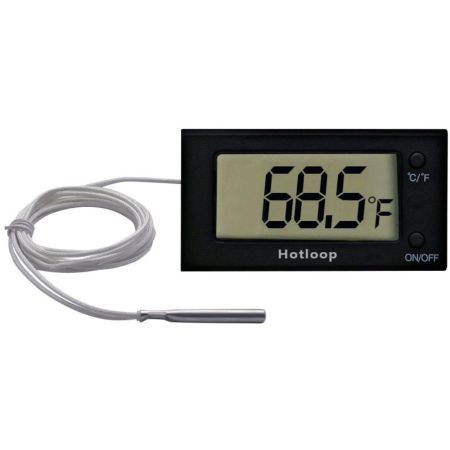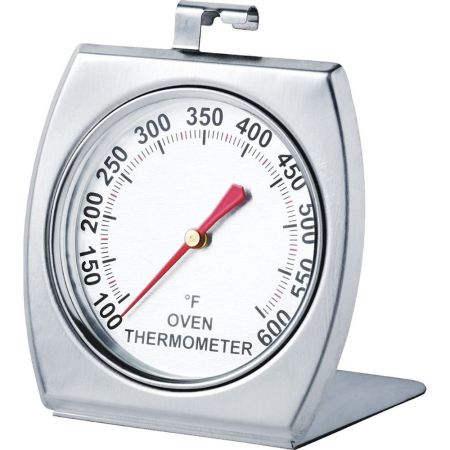We may earn revenue from the products available on this page and participate in affiliate programs. Learn More ›
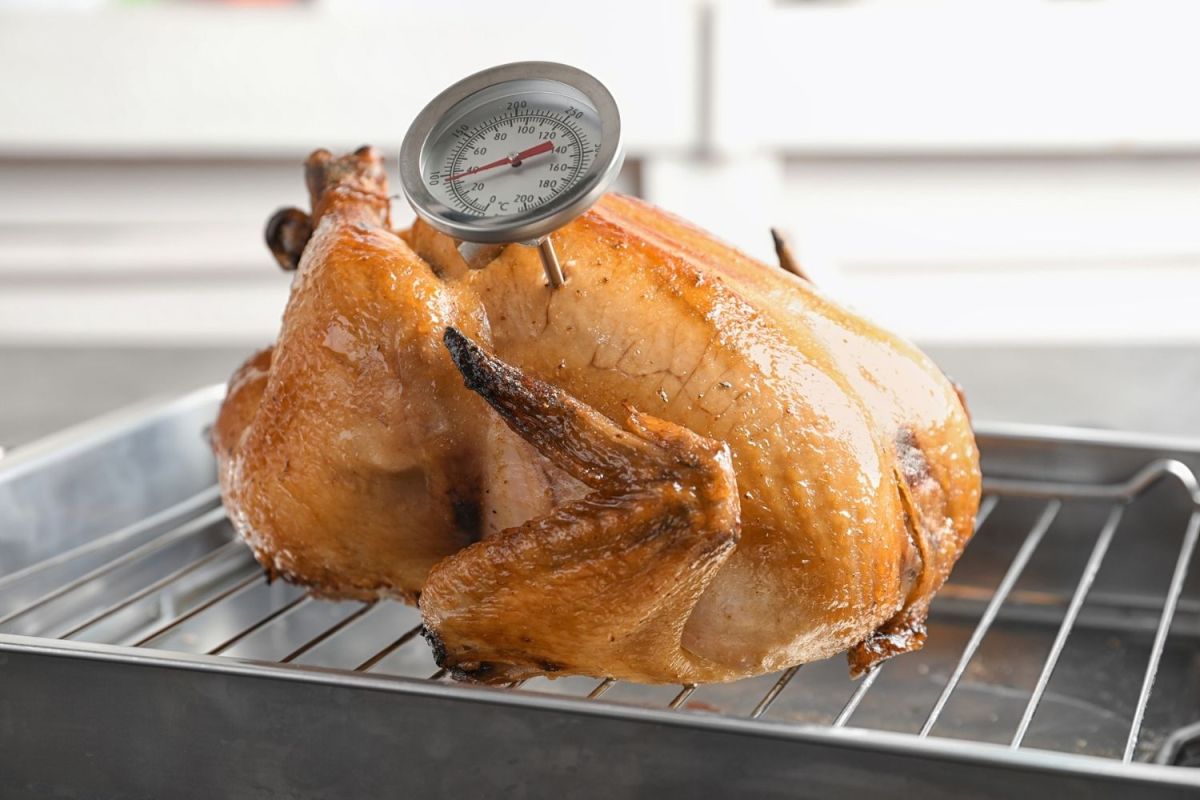
Producing heavenly baked goods and mouth-watering roasted fare is a combination of culinary skill and food science. For the tastiest—and most consistent—results, cook food at the temperature recommended in the recipe. Ovens come with built-in temperature regulators, but that doesn’t mean the oven isn’t cooking a bit on the hot or cool side. The best way to determine whether the oven is on target is to test it with an oven thermometer. These inexpensive cooking tools will quickly reveal whether the oven temperature matches the temp on the dial or whether the cook needs to adjust the oven temp higher or lower.
The best oven thermometer for you will depend on whether you want a digital probe-type model or prefer one with a dial and easy-to-read numbers. Ahead, learn more about this cooking calibrator and find out why any one of the following five can help maintain cooking uniformity.
- BEST OVERALL: KT THERMO Large 3” Dial Oven Thermometer
- BEST BANG FOR THE BUCK: Taylor TruTemp Series Oven/Grill Dial Thermometer
- MOST ACCURATE: CDN 09502000854 ProAccurate Oven Thermometer
- BEST DIGITAL: Hotloop Digital Oven Thermometer
- EASIEST TO READ: Admetior Kitchen Oven Large Dial Thermometer
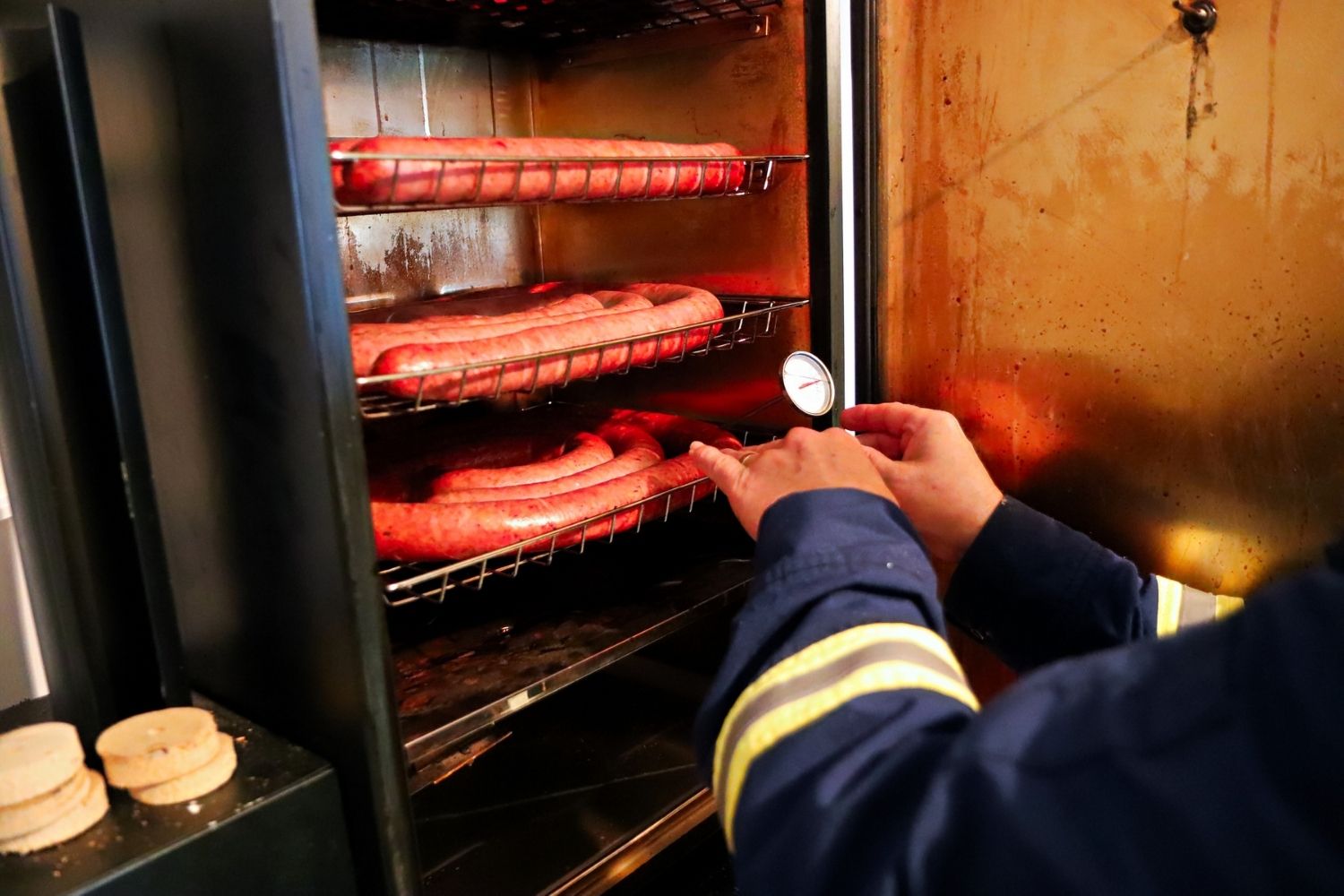
What to Consider When Choosing the Best Oven Thermometer
An oven’s built-in temperature gauge only registers the temperature at the spot where it’s located, often at the oven’s top back or side. If you have a convection oven that circulates air while cooking, the temperature throughout the oven will be more consistent, but it still may not be accurate. An oven thermometer is a simple, straightforward tool that allows a cook to determine if there’s a notable difference (25 degrees Fahrenheit or more) between the temperature dial or digital screen on the oven and the actual temperature inside.
If baked and roasted foods are coming out of the oven as expected, there’s no need to test the oven’s temperature. It’s only when foods regularly come out undercooked or overcooked that checking the temp is advisable. Keep in mind that the temperature in an oven increases and decreases during a normal cooking cycle. If the temperature is quite a bit higher or lower than the dial, however, the cook can use an oven thermometer to calibrate the oven.
Analog vs. Digital
Analog oven thermometers have been around for decades, and they’re a top choice for many bakers and chefs. Today’s cooks can also find a few digital models that closely resemble meat thermometers. Both have their good points.
- Analog: Designed to sit on an oven rack or a baking pan, or alternately, hang from beneath a rack via a clip, analog oven thermometers are most often round and feature a dial displaying the current oven temperature. If the oven door has a window, the cook can see an analog thermometer without opening the oven, which can cause the temp to drop.
- Digital: These handy thermometers are well-suited for ovens without windows in their doors. A metal probe clips to a rack in the oven, and a thin heat-proof cord runs to a digital LED screen placed outside the oven. Cooks can also use a traditional meat thermometer for the same purpose in a pinch.
Temperature Units & Limits
For best results, an oven thermometer should be able to read a wide range of temperatures. Most will read temperatures between 100 and 500 degrees Fahrenheit, and some will detect temperatures up to 600 degrees Fahrenheit. Many analog and digital thermometers also feature Celsius readings, which is handy for following recipes that only list Celsius temperatures. Analog thermometers typically show the temperature in 100-degree units, with lines to indicate 50, 25, and 10-degree temperature increments. A digital thermometer lets the cook see a more exact temperature—often to a tenth of a degree—on the LED readout.
Accuracy
When new, oven thermometers are relatively accurate, but after repeated use, they can become less precise. If you have a probe-type thermometer, you can test to see whether it’s still accurate by immersing the probe in boiling water. Water boils at sea level at 212 degrees Fahrenheit, although it will be slightly different at different altitudes and will vary by the current air pressure. For the greatest degree of accuracy, cooks can use an online boiling point calculator before testing a probe-type thermometer.
Analog oven thermometers usually aren’t waterproof, so don’t bother testing one in boiling water. Instead, plan on replacing it with a new one every year or so. When purchasing an oven thermometer, look for a National Sanitation Foundation (NFS) rating, which indicates the thermometer has been tested for accuracy.
Our Top Picks
The best oven thermometers should have a temperature detection scale of at least 100 to 500 degrees Fahrenheit and should be resilient and accurate. The following five models all fit that bill, and it wouldn’t hurt to pick up a couple to have an extra on hand. The right oven thermometer for you is one that will help you cook at the correct temperature, so your baked and roasted dishes consistently meet expectations.
Best Overall
KT THERMO Large 3” Dial Oven Thermometer
See ItThe KT THERMO Oven Thermometer is suitable for testing many types of cookers, including smokers, grills, and toaster ovens, as well as standard ovens. With a temperature scale of 150 to 600 degrees Fahrenheit, it’s also suitable for use in high-temp commercial ovens. Its case is made from stainless steel and features a shatterproof lens, and can be hung on the underside of a rack or positioned sitting up on a rack or a baking pan. The KT THERMO thermometer is NSF-rated and features both Fahrenheit and Celsius temperature scales.
Best Bang for the Buck
Taylor TruTemp Series Oven/Grill Dial Thermometer
See ItThe Taylor TruTemp Series Oven Thermometer is a high-end option at an attractive price point. The TruTemp analog thermometer features both Fahrenheit and Celsius scales, is NSF-rated, and measures temperatures from 100 to 600 degrees Fahrenheit, making it suitable for high-temp commercial ovens as well as standard models. The TruTemp thermometer can be positioned on a baking sheet, on an oven rack, or hung from the underside of a rack for testing.77
Most Accurate
CDN 09502000854 ProAccurate Oven Thermometer
See ItIn addition to providing both Fahrenheit and Celsius scales capable of registering temperatures up to 550 degrees and 290 degrees, respectively, the CDN ProAccurate Oven Thermometer offers a range of associated cooking heats. If you’ve ever tried recreating historical recipes, you know how difficult it can be to bake a cake in a “moderate” oven. The CDN thermometer provides commonly-used heating ranges from “warm” to “very hot” and “broil,” so you’ll have a good idea of how to set your oven when working from vague instructions. This stainless steel, analog oven thermometer is NSF-rated for accuracy and it can be placed on a pan or a rack or hung from the underside of a rack.
Best Digital
Hotloop Digital Oven Thermometer
See ItFor oven temperature readings accurate to a tenth of a degree, check out the Hotloop Digital Oven Thermometer. This digital oven thermometer features a temperature-sensitive probe and a heat-resistant wire that fits inside the oven while the digital readout remains outside. The Hotloop thermometer detects temperatures from 32 to 572 degrees Fahrenheit. Its probe is made from stainless steel, and it can double as a meat thermometer if desired. The Hotloop is handy for use in an oven that doesn’t have a window, so the cook doesn’t have to open the door to see the temperature inside.
Easiest to Read
Admetior Kitchen Oven Large Dial Thermometer
See ItIf you’re a bit nearsighted, consider this oversize analog thermometer. The large numbers on the 2.1-inch dial make it easy to read your oven’s temperature. This is strictly a Fahrenheit thermometer—no Celsius scale here—but the Admetior detects temperatures between 100 and 600 degrees. It features a shatterproof lens and a stainless steel case that can be set on a rack or a baking pan or hung from the underside of a rack for easy viewing.
FAQs About Your New Oven Thermometer
If the oven seems to be cooking either too hot or too cold, investing in an oven thermometer may help solve the problem of overcooked or undercooked foods. It’s natural to have some questions.
Q. Where is the best place to put an oven thermometer?
To test an oven’s temperature, place the thermometer or probe in the center of a rack that’s positioned (vertically) in the middle of the oven.
Q. Can I leave my thermometer in the oven?
There’s no hard and fast rule about leaving a thermometer in the oven while you cook, but frequent exposure to high heat may shorten its lifespan.
Q. How do I know if my oven thermometer is accurate?
If you have a probe-type oven thermometer, place the probe in boiling water. A reading between 200 and 214 degrees Fahrenheit is within the range considered accurate. The best way to ensure accuracy with an analog thermometer is to look for the NSF designation when purchasing and replace the thermometer annually.
Q. How do I calibrate my oven thermometer?
By figuring out the average temperature by which an oven is either too hot or too cold, the cook can then adjust the temperature on the dial for more consistent results.
- Place an oven thermometer (or probe) in the oven’s center and preheat the oven to 200 degrees Fahrenheit.
- When the oven finishes preheating, note the temperature difference on the thermometer. For example, if the oven is set to 200 degrees Fahrenheit, but the thermometer reads 225 degrees Fahrenheit, write down +25. If the thermometer reads 180 degrees Fahrenheit, write down -10.
- Repeat the preheating process five more times, increasing the oven’s temperature in 50-degree increments and noting temperature differences on the oven thermometer each time. Record the differences at 250 degrees, 300 degrees, 350 degrees, 400 degrees, and 450 degrees.
- Add the numbers together and divide by six. This will be the average temperature the oven cooks either too hot or too cold.
- The next time you preheat the oven, adjust the preheat temperature by the calibrated number.
